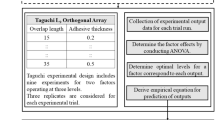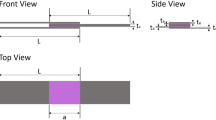Abstract
This study aims to survey the effects of crack length on the natural frequencies and mode shapes of adhesively bonded double-strap joints (DSJs) in the models with different adherend thicknesses and different adhesive ductility. Hence, the results of these analyses are used as a method of crack detection inside the adhesive layer. For this purpose, a rich database of results for DSJ models with cracks in length of 0 ≤ l C ≤ 10 mm were used for the aim of training the artificial neural network (ANN) algorithms. Subsequently, the results obtained from ANN models can be used to estimate the existence of crack and its length. The results show that the natural frequencies of the models with different adherend thicknesses and different adhesive ductility follow a logical trend, by which detection of cracks is possible for a wide range of geometries and material properties, using ANN analysis. By contrast, the results show that mode shapes are not affected by cracks. Therefore, the mode shapes are not useful characteristics for judgments.







Similar content being viewed by others
References
R.D. Adams, N.A. Peppiatt, Stress analysis of adhesive-bonded lap joints. J. Strain Anal. 9(3), 185–196 (1974)
R.D. Adams, W.C. Wake, Structural Adhesive Joints in Engineering (Elsevier Applied Science Publishers, Amsterdam, 1984)
A.J. Kinloch, The science of adhesion. 1. Surface and interfacial aspects. J. Mater. Sci. 15, 2141–2166 (1980)
L. Tong, Analysis and Design of Structural Bonded Joints/by Liyong Tong, Grant P. Steven (Kluwer Academic, Dordrecht, 1999)
W.C. Wake, Adhesion and adhesives: science and technology A. J. Kinloch (Chapman and Hall, London, 1987). pp. xii + 441, price £35.00. ISBN 0-412-27440-X, Br. Polym. J., 20(3), 300–300 (1988)
X. He, S.O. Oyadiji, Influence of adhesive characteristics on the transverse free vibration of single lap-jointed cantilevered beams. J. Mater. Process. Technol. 119(1–3), 366–373 (2001)
K.H. Almitani, R. Othman, Analytical solution of the harmonic response of visco-elastic adhesively bonded single-lap and double-lap joints. Int. J. Adhes. Adhes. 71, 55–65 (2016)
S.B. Ingole, A. Chatterjee, Vibration analysis of single lap adhesive joint: experimental and analytical investigation. J. Vib. Control 17(10), 1547–1556 (2011)
X. He, Finite element analysis of torsional free vibration of adhesively bonded single-lap joints. Int. J. Adhes. Adhes. 48, 59–66 (2014)
A. Kaya, M.S. Tekelioğlu, F. Findik, Effects of various parameters on dynamic characteristics in adhesively bonded joints. Mater. Lett. 58(27–28), 3451–3456 (2004)
R. Gunes, M. Kemal Apalak, M. Yildirim, I. Ozkes, Free vibration analysis of adhesively bonded single lap joints with wide and narrow functionally graded plates. Compos. Struct. 92(1), 1–17 (2010)
Y. Du, L. Shi, Effect of vibration fatigue on modal properties of single lap adhesive joints. Int. J. Adhes. Adhes. 53, 72–79 (2014)
U. Andreaus, P. Baragatti, Fatigue crack growth, free vibrations, and breathing crack detection of aluminium alloy and steel beams. J. Strain Anal. Eng. Des. 44(7), 595–608 (2009)
U. Yuceoglu, O. Güvendik, Effects of position (or location) of non-centrally bonded symmetric double lap joint (or symmetric double doubler joint) on bending vibrations of composite mindlin plates or panels. in ASME 2010 International Mechanical Engineering Congress and Exposition (American Society of Mechanical Engineers, 2010) pp. 595–618
S. Haykin, Neural Networks: A Comprehensive Foundation (Prentice Hall PTR, Upper Saddle River, 1998)
M.K. Apalak, R. Ekici, M. Yildirim, Optimal design of an adhesively bonded corner joint with single support based on the free vibration analysis. J. Adhes. Sci. Technol. 20(13), 1507–1528 (2006)
M. Kemal Apalak, R. Ekici, M. Yildirim, Free vibration analysis and design of an adhesively bonded corner joint with double support. J. Adhes. 83(11), 957–986 (2007)
Author information
Authors and Affiliations
Corresponding author
Rights and permissions
About this article
Cite this article
Paygozar, B., Sadigh, M.A.S. Detection of Cracks in Adhesively Bonded Double-Strap Joints Using Artificial Neural Network Method. J Fail. Anal. and Preven. 17, 1023–1030 (2017). https://doi.org/10.1007/s11668-017-0338-8
Received:
Published:
Issue Date:
DOI: https://doi.org/10.1007/s11668-017-0338-8




